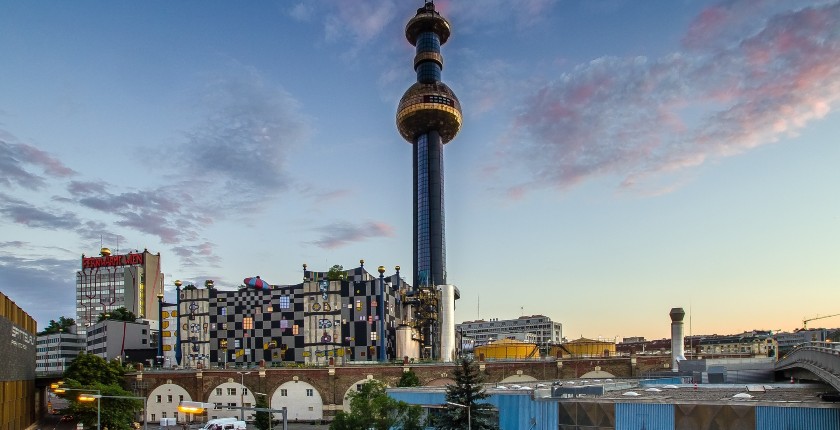
Incinerator in Vienna (photo: andreas N from Pixabay)
Using waste as an alternative fuel is a controversial issue in Serbia. Some approve of it and promote it as an excellent way to reduce waste pollution, obtain energy, and help combat climate change, while others organize protests, fearing waste-to-energy plants in their communities would cause air pollution. However, even the biggest skeptics, faced with the excessive production of waste and ever increasing quantities of it ending up in landfills or the environment, cannot but ask themselves whether waste incineration is a solution that could help get rid of waste as well as take advantage of its positive sides. Energy recovery, after all, is a legitimate element of the waste management hierarchy, one that comes before landfilling, and this should always be kept in mind.
While waste-to-energy in Serbia is only just emerging, the European Union (EU) has long embraced this concept: in 22 EU members states, there are 155 facilities generating energy from hazardous waste and as many as 497 using non-hazardous waste from households, industry, and the building sector as an alternative fuel.
Waste that cannot be recycled – whether for technical inability to be turned into new products or the complex and costly separate collection process as a requirement for mechanical recycling – ends up in waste-fueled combined heat and power plants, also known as cogeneration plants. Technology-wise, these facilities are a more advanced solution than traditional incinerators, which merely burn waste without turning it into energy. Also, such energy is produced locally and at a low cost, helping increase energy security.
Landfilling doesn’t pay off in the EU
According to Eurostat data, 48% of all municipal waste generated in the EU in 2019 was recycled or composted, 27% was used to produce energy, and 24% ended up in landfills.
There are no accurate data for Serbia, but it is estimated that over 90% of the country’s municipal waste ends up in sanitary or unsanitary landfills, including a significant portion of industrial waste that can be used for energy recovery.
In the EU, 24% of municipal waste is landfilled, compared to over 90% in Serbia
Austria, Belgium, Denmark, Finland, the Netherlands, Germany, and Sweden are the EU’s top performers when it comes to reducing the amounts of waste that end up in landfills, with landfilling rates of below 4%. On top of that, some countries, such as Austria, have banned the landfilling of waste that has not undergone some form or treatment or recycling. According to the Confederation of European Waste-to-Energy Plants (CEWEP), in most of these countries landfilling has been outlawed and waste is used to recover energy instead.
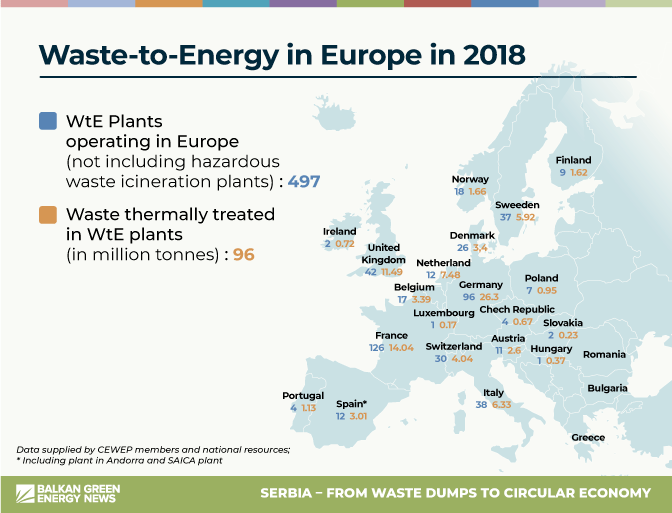
The EU’s experience shows it is virtually impossible to prevent waste from ending up in the environment without imposing a ban on landfilling, restrictions on the type of waste that can be landfilled (according to its heat value), or at least introducing a landfilling tax, but it is also impossible as long as landfilling remains cheaper than the treatment of waste for re-use or energy recovery. Moreover, one should keep in mind that even sanitary landfills have a significant and long-lasting adverse impact on the environment due to greenhouse gas emissions.
Energy recovery from waste is strictly regulated in the EU
In the EU, waste-to-energy activities are regulated by strict and clearly defined rules in all sectors of industry. Low emission limit values and other provisions of the EU’s Industrial Emissions Directive are applied from the very first kilogram of waste utilized in the waste-to-energy process.
These regulations apply to a wide range of emissions, including dust, nitrogen oxides, sulfur dioxide, 12 different heavy metals, dioxins, and other organic pollutants. On top of that, the regulations cover permitting, operation, emissions monitoring, the thermal treatment of hazardous waste, the treatment of incineration residues, the purification of waste gases, reporting requirements, environmental inspections, public information, and many other areas.
Serbia has adopted legislation, but needs to ensure its consistent implementation
Serbia has harmonized its regulations in this field with the EU acquis to a significant extent, and its law requires waste-to-energy plants to operate in line with the most stringent environmental standards, with a minimum impact on the environment and the population and with the application of the best technologies.
On the other hand, to build lasting public trust in the technology itself and ensure proper monitoring and oversight over these facilities, it is necessary to make significant progress on the quality of inspection services and the monitoring and public information systems, but also to ensure adequate public information and engagement.
In this latest article in the series “Serbia, from garbage dumps to circular economy”, we discuss the waste-to-energy concept with Professor Vladimir Pavićević from the environmental protection engineering department at the Faculty of Technology and Metallurgy in Belgrade, Igor Jezdimirović, chairman of the Environment Engineering Group, and Helga Stoiber, an expert on waste-to-energy plants and senior partner at Austrian consultancy UVP.
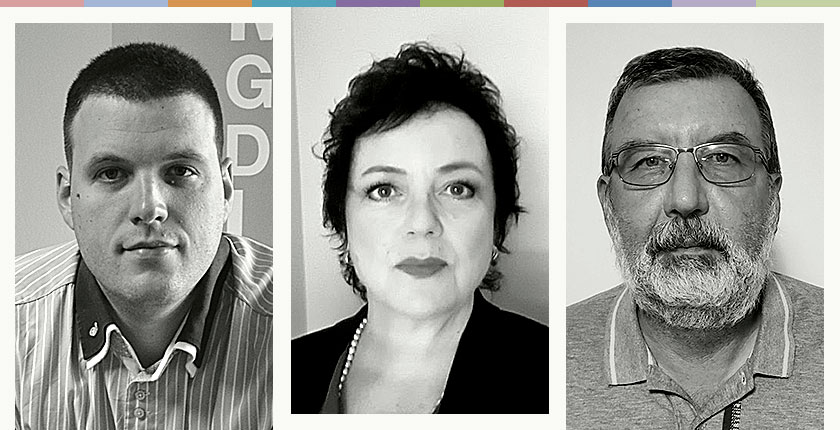
Only waste that cannot or should not be recycled is suitable as an alternative fuel
Asked whether Serbia needs waste-to-energy facilities, Igor Jezdimirović, chairman of the Environment Engineering Group, says that part of the waste we generate today cannot be recycled or re-used, but that it does have an energy value, and its use as an alternative fuel is justified in that sense. However, utilizing the energy potential of waste requires adequate facilities with the necessary environmental protection measures in place, as well as suitable disposal sites for incineration residues.
Jezdimirović says that the proper use of waste for this purpose, and the protection of the environment, should be guaranteed by the institutions overseeing the work of such facilities, and that it should by no means be allowed to burn those waste fractions which can be re-used or recycled.
Vladimir Pavićević from the Faculty of Technology and Metallurgy says the question of whether waste incinerators should be built in Serbia is a tough one, but he adds that there are numerous good examples out there, and that such facilities are an acceptable solution if everything is done right.
An incinerator for some streams of waste – hazardous, pharmaceutical, or chemical – are inevitable in Serbia, according to him.
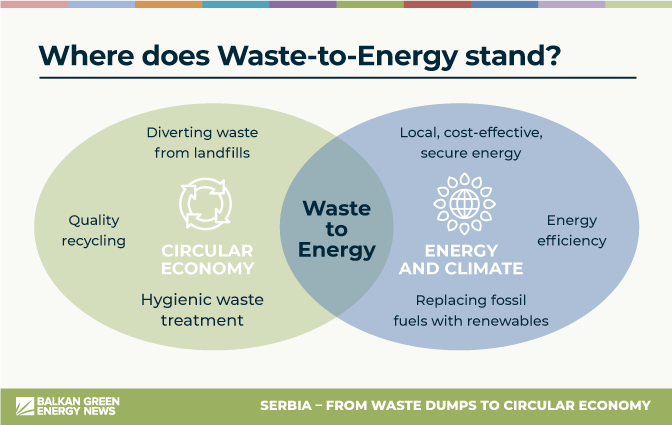
“The issue of waste export for energy recovery abroad is becoming more and more difficult for Serbia because companies have to wait years to have their waste exported, while it is also possible that waste import into those countries will be banned in the coming years. For that reason, export is not a solution, and it would be best for Serbia to have its own facility,” says Pavićević. It is worth mentioning that Serbia has had serious problems with illegally buried or stored industrial waste. There is no need to emphasize the harmful effects of such practice, which is still possible in Serbia due to the lack of waste recycling and energy recovery facilities and the high prices of waste export, but also because of the poor performance of inspection services and because businesses intentionally resort to it in order to save money.
Serbia needs to treat its waste, says Pavićević, adding that one way to do that is to turn it into energy. Serbia, according to him, should build one incinerator for hazardous waste, for waste that cannot be disposed with municipal waste, but also for part of industrial waste.
“Energy recovery from waste is one of the alternatives Serbia must consider. Prevention and recycling are better, but energy recovery is still preferable to landfilling, a practice that is the most widespread in Serbia and which has the worst impact on the environment. When incinerators are operated properly, they are not a health hazard,” according to him.
Pavićević also insists that Serbia must launch serious public consultations on the issue of waste-to-energy.
Helga Stoiber, an expert on energy recovery from waste and senior partner at Austrian waste management consultancy UVP, confirms that incineration is the best way to treat certain types of waste, both in terms of technology and the maximum protection of the environment and human health.
For example, she says, infectious hospital waste is completely sanitized during the incineration process given that all harmful substances and microorganisms, including bacteria and viruses, are destroyed by heat. Another example is hazardous waste that contains hazardous organic substances, such as dioxins and furans, which can also be destroyed in incinerators.
In recent years, experts have been highlighting the short-term benefits of incinerators in preventing climate change. When waste is landfilled, the decomposition of its organic components (food, wood, paper, cardboard) releases methane, a greenhouse gas that is 20 times as harmful to the climate as carbon dioxide, which is released during incineration. In the first years, methane is up to 80 times more potent compared to CO2, though methane is decomposed after 12 years, while CO2 takes much longer – about 50% of emitted CO2 is decomposed in the atmosphere within 30 years, a further 30% will disappear from the atmosphere over the following several centuries, while the remaining 20% will stay in the atmosphere for thousands of years.
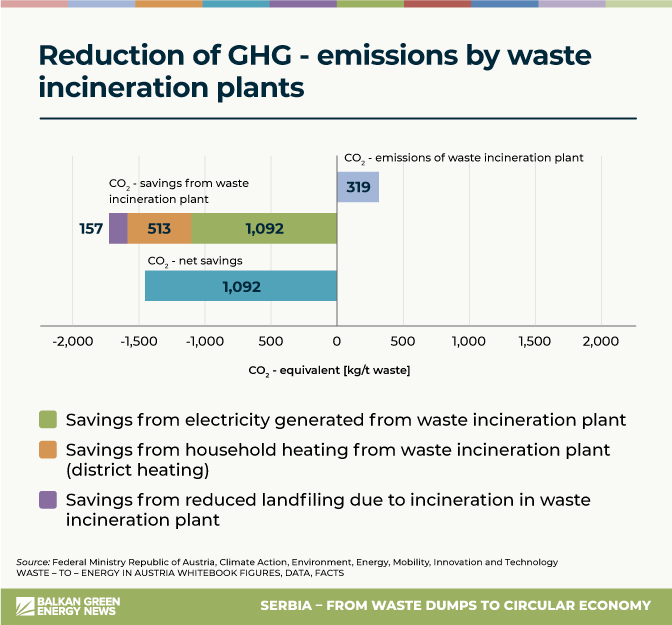
The energy crisis – an incentive to embrace waste-to-energy
Aside from tackling certain streams of waste, thermal treatment also provides energy – heat and electricity, as well as steam – making it a worthwhile investment amid the energy crisis, which has pushed electricity prices on wholesale markets across Europe to a whopping EUR 700 per MWh, 15 times as high as the levels seen before the crisis.
According to data from the Confederation of European Waste-to-Energy Plants (CEWEP), the 497 waste-to-energy plants in the EU generated 41,000 GWh of electricity and 96,000 GWh of heat in 2018. The electricity output was enough to cover the needs of 19 million consumers, while the heat production was sufficient for 16,000 million consumers.

The rise in energy prices on the world market due to the crisis in Ukraine has made the issue of using waste as a substitute for gas, coal, and fuel oil relevant in Serbia as well. Even before the crisis, cement plants in Serbia, as well as throughout Europe, started replacing fossil fuels with alternative fuels such as waste. Apart from the cement factories in Popovac and Beočin, which have been using certain types of fuel as a substitute for petroleum coke for several years, the cement plant in Kosjerić is also trying to ensure the support of the local community for this technology.
State power utility Elektroprivreda Srbije (EPS) is also considering compensating for the lack of quality coal in its power plants with municipal and other waste suitable for electricity production. The construction of incinerators in Niš and Kragujevac is planned under the Clean Serbia project implemented by the Ministry of Construction, Infrastructure, and Transportation and financed from a Chinese loan. Elixir, Serbia’s sole artificial fertilizer producer and one of the country’s biggest exporters, also sees waste as a solution for stable and secure heat supply. By the end of 2024, the company plans to build a waste-to-energy plant in the industrial-chemical complex in Prahovo, which would be supplied with waste from households in eastern Serbia, but would also use industrial waste (hazardous and non-hazardous) from all over the country. This plant would be the first facility in Serbia for hazardous waste treatment, built in line with the highest EU standards, which would solve the country’s decades-long problem of the treatment of this type of waste.
Also, a municipal waste incinerator at the Vinča landfill will soon be put into operation. The facility, which will burn 340,000 tons of waste a year, will have a capacity of 30 MW for electricity and 56 MW for thermal energy, supplying heat to residents of the Belgrade neighborhood of Konjarnik through the Serbian capital’s district heating system.
Incinerators are a solution, but only if the highest standards are observed
Due to the existing problems with air pollution in Serbia and increased values of particulate matter (PM), especially during the heating season, citizens’ fears about the potential harmful impact of additional emissions into the air are understandable, especially considering that the public knows very little about these technologies.
Asked about ways to overcome the public distrust and operate waste-to-energy plants with minimal risk to the environment and the population, the three experts we talked to agreed that it is necessary to ensure compliance with the standards in the operation of both existing and future plants. Existing incinerators in European capitals have demonstrated that the technology is safe, but there were also some bad examples in past in terms of high levels of harmful gas emissions. The problem was resolved with the continuous improvement process (CIP).
A simple way to avoid potential risks is to apply the Best Available Techniques (BAT), regulated by the EU’s Best Available Techniques Reference Document for Waste Incineration (BREF WI). Modern technologies have advanced to such an extent that they enable the emissions of harmful gases during waste treatment to be lower than those generated by landfilled waste.
“Measurements in one of the Austrian waste-to-energy facilities carried out in the 1990s showed that the total amount of dioxins and furans coming out of an incinerator in the form of emissions was significantly smaller than the amount of dioxins and furans contained in the waste before incineration, which means that the facility destroys these harmful substances. These results were later confirmed by similar data published by German authorities,” says Stoiber.
Igor Jezdimirović says that most plants that use waste as an alternative fuel have similar technological solutions, but that the incinerators in Budapest, Malmö, and Vienna left the best impression on him.
These plants have serious environmental protection measures in place, along with professional staff operating the facilities, while the relevant state institutions are applying tight pollution control measures, according to him. In these countries, failures to address excess pollution in the shortest possible time are fined heavily. “The interest of the state is to protect the health of citizens, and this is consistently implemented,” says Jezdimirović.
Austria has a 60-year long tradition of waste incineration
Helga Stoiber says that Austria’s first incinerator was put into operation in 1961 and that Austrian plants are designed, built, and operated in accordance with the Best Available Techniques. A review of BREF WI documents, using data from about 300 incinerators in various countries, showed that Austrian facilities were almost always among the top environmental performers.
These plants are also very often located in large cities
Interestingly, these plants are also very often located in large cities, such as Amager Bakke in Copenhagen, Denmark, Sysav in Malmö, Sweden, or Spittelau in Vienna, Austria. The incinerator in Copenhagen is near the opera house and is also designed as a ski slope; the hazardous waste incinerator Valorec in Basel, Switzerland is right next to a local shopping center; and Vienna’s incinerator is located near a university and the General Hospital, supplying it with energy for heating and cooling.
Stoiber also says that the BREF WI regulations are very clear regarding the requirements for the design and operation of incinerators. For example, BREF WI stipulates that cyclones can be used for pre-dedusting (e.g. before bag filters and electrostatic precipitators), but that they do not have to be used as the sole dust removal technique.
“Under the previous BREF WI, from 2006, discontinuous measurement for 5-8 hours twice a year was considered the best practice for dioxin and furan concentration monitoring. However, the current BREF WI, published in 2019, stipulates that monitoring must be carried out through long-term sampling over a period of several weeks or months. Only if the results of such measurements are in line with the emission limit values defined by BAT, discontinuous monitoring can be carried out twice a year instead,” says Stoiber.
Hundreds of parameters are constantly measured in such facilities
Hundreds of parameters are constantly measured in such facilities, and all measured data is monitored in the incinerator’s control room, she says. Every two or three seconds, information arrives online about temperatures, pressures, gas flows, electricity consumption of fans and pumps, the dosage of flue gas cleaning agents, concentrations of emissions in the chimney, energy production, she explains.
The core software registers all data and performs technical settings, while well-trained professional staff is present on site 24 hours a day, carefully operating the plant, according to Stoiber.
To be successful in this business, you need to apply the Best Available Techniques
In Austria, the nine provincial governments are in charge of overseeing the operation of incinerators. Their experts not only evaluate the design of the plant during the permitting stage, but are also engaged in the environmental inspection of the plant. The advantage of this approach, according to Stoiber, is in that the expert who controls the technical and environmental performance of the plant on behalf of the government is familiar with the project from the very beginning.
Over the past few years, Serbia has adopted the EU’s environmental laws, Stoiber notes, adding that their implementation is an important factor in the protection of human health and the environment.
“To be successful in this business, you need to apply the Best Available Techniques (BAT), train the plant’s staff well, build administrative capacities, engage experts within the institutions that issue permits, and conduct thorough inspections aimed at protecting the environment”, according to Stoiber.
Modern technology supported by strict control and monitoring
With the construction of a waste-to-energy plant at Belgrade’s Vinča landfill, Serbia has taken the first step in the utilization of waste for energy production. Experts from Serbia and abroad agree that this modern technology helps address non-recyclable waste and protect the environment by reducing the need for landfilling. The technology also reduces greenhouse gas emissions, mitigating the impact on climate change, while providing a source of scarce energy sources for the production of heat and electricity.
In order to fully utilize waste-to-energy technology, it is necessary to take into account the experience and advice from countries which have had such facilities for years and which have seen both their good and bad sides. That is why a strict enforcement of regulations, and oversight over these facilities, is a prerequisite for the technology to get the green light not only from businesses and decision-makers, but also from the public.
GOOD TO KNOW
WASTE TREATMENT – waste re-use or disposal operations, including the preparation for re-use or disposal.
WASTE-TO-ENERGY FACILITIES; WASTE INCINERATORS – facilities for the thermal treatment of waste (combustion). There are two types of treatment: incineration and co-incineration.
WASTE INCINERATION (COMBUSTION) – thermal treatment of waste with or without energy recovery, which includes pyrolysis, gasification, and plasma combustion.
CO-INCINERATION; ENERGY RECOVERY FROM WASTE – thermal treatment of waste with the primary purpose of producing energy or solid products where waste is used as main or auxiliary fuel or in which waste is burnt for the purpose of disposal.
HAZARDOUS WASTE – waste that displays at least one of the properties that make it hazardous (explosiveness, flammability, tendency to oxidation, acute toxicity, infectivity, corrosiveness, is an organic peroxide, releases flammable gases in contact with air, releases toxic substances in contact with air or water, contains toxic substances with delayed chronic effects, has ecotoxic properties), as well as packaging in which hazardous waste was or is kept.
MUNICIPAL WASTE – waste from households (household waste) and commercial waste.


















Be the first one to comment on this article.